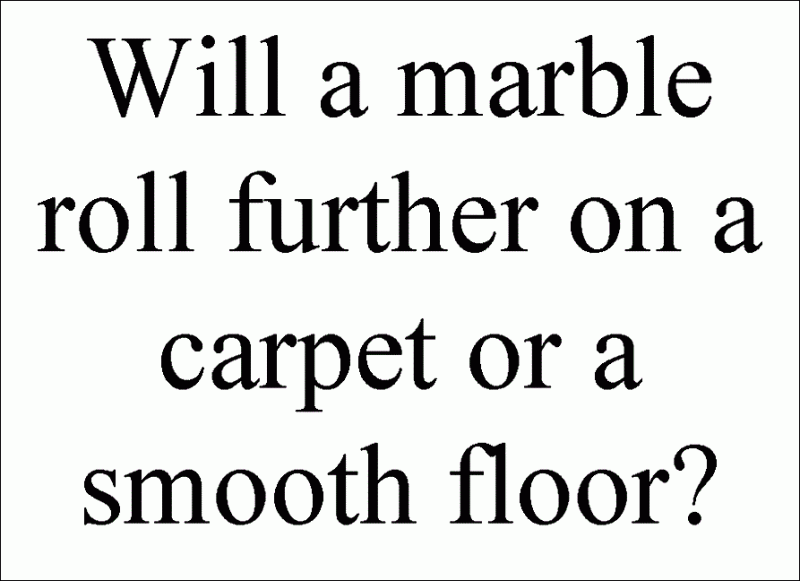Rolling marbles
|
Choose two cards that show how to plan a fair test to answer the question, "Will a marble roll further on a carpet or a smooth floor?" . You will need to think about what has to stay the same, and what will need to change.
a) Show your teacher the two cards you have chosen. b) Tell your teacher why you chose those two and not two others. |
|
Set of cards for each group.
|
 |
- This task requires students to choose the pair of cards that make a fair test.
- The teacher will need to make up the cards before students work on the task (each group will have eight cards).
- This task could be completed in small groups, or pairs, and children can respond orally to the follow up question.
- Display and read the question, "Will a marble roll further on a carpet or smooth floor?"
- Ask the children to select two cards that would be a fair test to answer the question from the provided set.
- Once the students have had their choices checked they could carry out the investigation. Rolling marbles II follows on from this resource.

| a) |
Any 1 of:
|
| b) |
Any answer that indicates that the marble and ramp slope have to be kept the same to keep the test fair; or Any answer that indicates that the surface has to change because that is the variable being tested. |
During the trials some students, when answering b), gave reasons to do with their ideas about what would affect the outcome; for example, a little marble won't go as far, a marble on a steeper slope will gather more speed. These types of comments could be a good starting point for further investigation.
Further questions students could plan an investigation for using these cards, are:
Will a big marble or a small marble roll further?
[Any 1 of: A and F, H and D, E and G, C and B]
Will a marble roll further down a steep slope, or a gentle slope?
[Any 1 of: A and E, G and F, C and H, D and B]
Research
Research suggests that students can recognise "fair tests" before they are able to produce these independently. Many students can "do" more than they can talk about. They find it difficult to say why a test is "fair" or not. This is more obvious at Year 4 than Year 8.
Providing students with opportunities to select fair tests during assessment might allow them to better display their developing skills (Hipkins and Kenneally, 2003).
Further reading about this research:
- Ministry of Education (2003). NEMP probe study findings 2003. Dunedin: Educational Assessment Research Unit. Developing children's science investigation skills, page 14, provides a clear teacher-friendly summary of a research project by Rose Hipkins and Natasha Kenneally about children's science investigation skills.
- Hipkins, R. and Kenneally, N. (2003). Using NEMP to inform the teaching of science skills. Wellington: New Zealand Council for Educational Research.
- Hipkins, R. and Kenneally, N. (2003). Simple teaching strategies to use during primary science investigations. Paper presented at ASERA Conference, Melbourne, July 8-12, 2003.
- Ministry of Education (2003). Marbles. Building Science Concepts, Book 42. Wellington: Learning Media.
- Ministry of Education (1999). Making better sense of the physical world. Wellington: Learning Media. In the section on forces and motion, Activities 10-12, pages 118-119, explore friction.
- Rolling marble II follows on from this resource. It provides a useful strategy for measuring the distance travelled, and assesses the students' ability to process the information collected.

